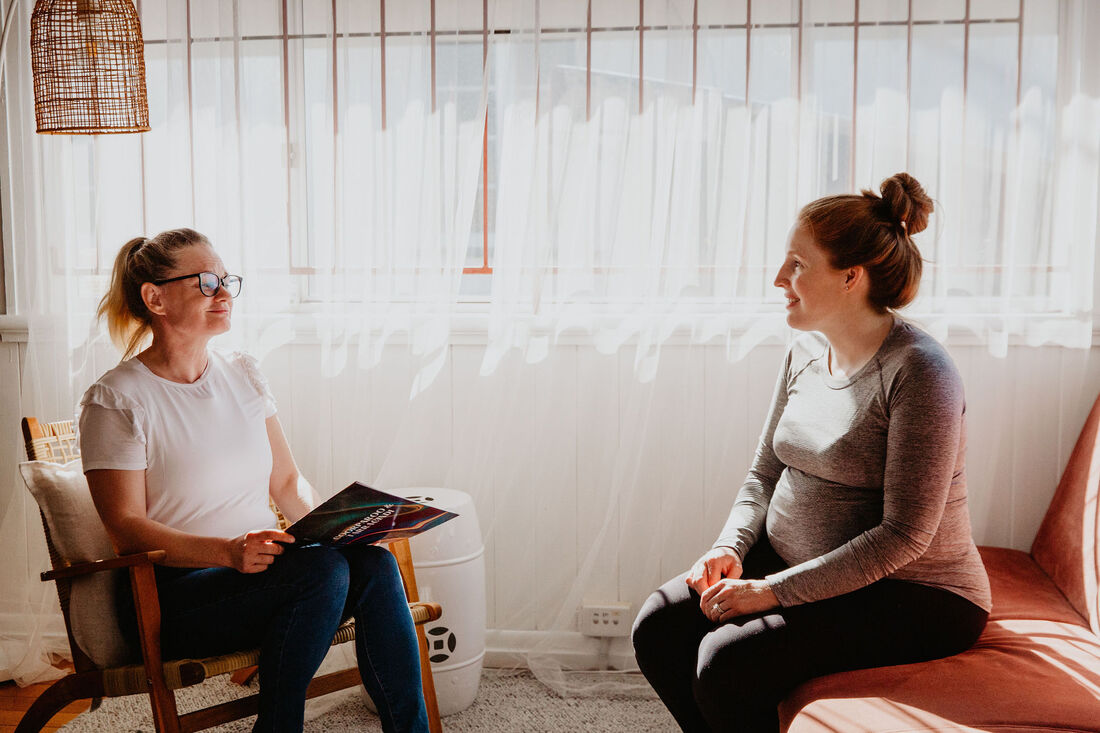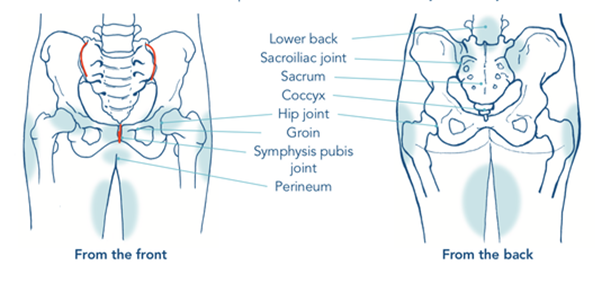Pelvic Girdle Pain Physiotherapy Brisbane Southside.
What is pelvic Girdle pain?
Pelvic girdle pain (PGP) refers to discomfort or pain experienced in the pelvic region, specifically in the area of the pelvis that includes the sacroiliac joints, pubic symphysis, and surrounding muscles and ligaments. PGP is a common condition that can affect both men and women, although it is most commonly associated with pregnancy.
The symptoms of pelvic girdle pain can vary but often include:
Management and treatment of PGP typically involve a multidisciplinary approach, including physiotherapy, pain management techniques, exercises to improve core stability and muscle strength, manual therapy, and modifications to daily activities or posture. It's important to consult with a healthcare professional, such as a physiotherapist or doctor, for an accurate diagnosis and tailored treatment plan based on your specific symptoms and circumstances.
What is Pregnancy Related Pelvic Girdle Pain?
Pregnancy is an amazing time in a woman's life, as the body adapts and changes to prepare for childbirth. With these changes one of the most common issues women experience is pregnancy related pelvic girdle pain (PrPGP), that is pain in the front or back of the pelvic regions as shaded in the diagram below.
Pelvic girdle pain (PGP) refers to discomfort or pain experienced in the pelvic region, specifically in the area of the pelvis that includes the sacroiliac joints, pubic symphysis, and surrounding muscles and ligaments. PGP is a common condition that can affect both men and women, although it is most commonly associated with pregnancy.
The symptoms of pelvic girdle pain can vary but often include:
- Pain in the lower back: This pain may be localised or radiate to the buttocks, hips, groin, or thighs.
- Pain around the sacroiliac joints: The sacroiliac joints connect the sacrum (triangular bone at the base of the spine) to the ilium bones of the pelvis. PGP can cause pain and discomfort in this area.
- Pain in the pubic area: PGP can cause pain and tenderness in the pubic bone or the symphysis pubis, which is the joint at the front of the pelvis.
- Difficulty with weight-bearing activities: Activities such as walking, climbing stairs, standing, or turning in bed may exacerbate the pain or be challenging to perform.
- Clicking or grinding sensations: Some individuals may experience clicking or grinding sensations in the pelvic region.
Management and treatment of PGP typically involve a multidisciplinary approach, including physiotherapy, pain management techniques, exercises to improve core stability and muscle strength, manual therapy, and modifications to daily activities or posture. It's important to consult with a healthcare professional, such as a physiotherapist or doctor, for an accurate diagnosis and tailored treatment plan based on your specific symptoms and circumstances.
What is Pregnancy Related Pelvic Girdle Pain?
Pregnancy is an amazing time in a woman's life, as the body adapts and changes to prepare for childbirth. With these changes one of the most common issues women experience is pregnancy related pelvic girdle pain (PrPGP), that is pain in the front or back of the pelvic regions as shaded in the diagram below.
Onset typically occurs during the second and third trimester, with an estimated prevalence of 60-70% of women reporting some degree of PrPGP by late pregnancy. Symptoms often increase in intensity and severity as pregnancy progresses, and pain can often feel worse as the day goes on. This type of pain can make it difficult to do everyday activities, such as walking, using stairs or turning in bed.
What causes Pregnancy Related Pelvic Girdle Pain?
While no single factor has been proven as the cause of PrPGP, it is thought to be a combination of multiple changes in the body through pregnancy. Hormonal variations prepare the body for childbirth by increasing soft tissue laxity and sensitivity throughout the body, including the pelvic region. The pelvic region is a strong, stable complex that is made up of bones, joints, and muscles that connect the legs to the trunk of the body. During pregnancy, these structures need to work harder to support the extra weight and biomechanical changes brought on with the growing baby. Combined with hormonal changes, it is thought that this extra stress can lead to PrPGP in some women.
Can pelvic girdle pain occur outside of pregnancy?
Yes, pelvic girdle pain (PGP) can occur outside of pregnancy. While PGP is commonly associated with pregnancy due to the changes in the body during that time, it can also affect individuals who are not pregnant. PGP can occur in both men and women and may result from various factors, including:
What is the best treatment for Pregnancy Related Pelvic Girdle Pain?
It is important to understand that PrPGP is not harmful to you or your growing baby, although it can significantly impair function especially in the later stages of pregnancy. In most cases, PrPGP will resolve after baby is born as hormones stabilise again.
The Australian Pregnancy Care Guidelines share the following pieces of advice for women with PrPGP:
Pregnancy-specific exercises with physiotherapy advice and using a support garment (such as a sacro-illiac joint belt, flexible tubigrip, or medical compression pants) may also provide relief.
How can clinical pilates help with pelvic girdle pain?
Clinical Pilates can be a valuable approach in managing and relieving pelvic girdle pain (PGP). PGP refers to discomfort or pain experienced in the pelvic region, including the sacroiliac joints, pubic symphysis, and surrounding muscles and ligaments. Here's how Clinical Pilates can help with PGP:
It's important to remember that PGP can have various underlying causes, and not all exercises or approaches may be suitable for everyone. Therefore, it's recommended to work with a qualified physiotherapist or healthcare professional experienced in Clinical Pilates or pelvic health. They can assess your condition, provide tailored exercises and modifications, and guide you through a safe and effective rehabilitation program.
Our Women's Health Physiotherapists are experts in helping you stay active and moving despite pelvic girdle pain. They are also experts in deciding after a thorough assessment which treatment options are best for you. If you are experiencing pelvic pain and would like to book an appointment, please don't hesitate to book in via the link below or call our friendly reception team on 07 3706 3407. We would love to help you.
What causes Pregnancy Related Pelvic Girdle Pain?
While no single factor has been proven as the cause of PrPGP, it is thought to be a combination of multiple changes in the body through pregnancy. Hormonal variations prepare the body for childbirth by increasing soft tissue laxity and sensitivity throughout the body, including the pelvic region. The pelvic region is a strong, stable complex that is made up of bones, joints, and muscles that connect the legs to the trunk of the body. During pregnancy, these structures need to work harder to support the extra weight and biomechanical changes brought on with the growing baby. Combined with hormonal changes, it is thought that this extra stress can lead to PrPGP in some women.
Can pelvic girdle pain occur outside of pregnancy?
Yes, pelvic girdle pain (PGP) can occur outside of pregnancy. While PGP is commonly associated with pregnancy due to the changes in the body during that time, it can also affect individuals who are not pregnant. PGP can occur in both men and women and may result from various factors, including:
- Injury: Trauma or injury to the pelvic region, such as falls, accidents, or sports-related incidents, can lead to pelvic girdle pain.
- Overuse or Repetitive Strain: Repetitive activities, such as certain occupational tasks or sports that place excessive stress on the pelvis, can contribute to the development of PGP.
- Postural Issues: Poor posture, such as prolonged sitting with improper alignment, can lead to imbalances and strain on the pelvic joints and muscles, resulting in pain.
- Joint Dysfunction: Issues with the sacroiliac joints, pubic symphysis, or other pelvic joints, such as arthritis, inflammation, or instability, can cause pelvic girdle pain.
- Muscle Imbalances: Imbalances in the muscles surrounding the pelvis, including the hip muscles, glutes, and pelvic floor muscles, can lead to PGP.
- Inflammatory Conditions: Certain inflammatory conditions, such as sacroiliitis, can cause inflammation and pain in the pelvic girdle region.
- Previous Surgeries: Pelvic surgeries, such as hip replacements or pelvic organ surgeries, can sometimes result in PGP.
What is the best treatment for Pregnancy Related Pelvic Girdle Pain?
It is important to understand that PrPGP is not harmful to you or your growing baby, although it can significantly impair function especially in the later stages of pregnancy. In most cases, PrPGP will resolve after baby is born as hormones stabilise again.
The Australian Pregnancy Care Guidelines share the following pieces of advice for women with PrPGP:
- Wear low-heeled shoes
- Reduce non-essential weight bearing activities, for example taking an elevator instead of walking up stairs
- Minimise time standing on one leg, for example sit down to get dressed
- Modify techniques for activities such as rolling in bed and getting in/ out of the car, by keeping your knees together
- Apply heat or to painful areas. It is best to be advised by your physiotherapist which one suits your condition best.
Pregnancy-specific exercises with physiotherapy advice and using a support garment (such as a sacro-illiac joint belt, flexible tubigrip, or medical compression pants) may also provide relief.
How can clinical pilates help with pelvic girdle pain?
Clinical Pilates can be a valuable approach in managing and relieving pelvic girdle pain (PGP). PGP refers to discomfort or pain experienced in the pelvic region, including the sacroiliac joints, pubic symphysis, and surrounding muscles and ligaments. Here's how Clinical Pilates can help with PGP:
- Core Stability: Clinical Pilates focuses on strengthening the deep core muscles, including the transversus abdominis, pelvic floor, and multifidus muscles. By enhancing core stability, these exercises can provide better support and control to the pelvic region, which may help alleviate pain and improve functional movement.
- Postural Alignment: Clinical Pilates emphasises proper alignment and postural awareness. Correcting postural imbalances and maintaining optimal alignment can help reduce stress and strain on the pelvic joints, muscles, and ligaments, leading to pain relief.
- Pelvic Floor Muscle Activation: Clinical Pilates includes exercises that specifically target the pelvic floor muscles. Strengthening these muscles can enhance their ability to support the pelvic organs and stabilise the pelvic girdle, potentially reducing pain and improving pelvic floor function.
- Stretching and Mobilisation: Clinical Pilates incorporates exercises that focus on gentle stretching and mobilisation of tight and stiff muscles around the pelvis, including the hip flexors, glutes, and deep hip rotators. These exercises can help alleviate muscle tension, improve flexibility, and restore proper joint range of motion.
- Body Awareness and Movement Control: Clinical Pilates emphasises body awareness and mindful movement. By becoming more aware of movement patterns and learning how to control movements in a coordinated and efficient manner, individuals with PGP can reduce excessive strain on the pelvic girdle and improve overall functional movement.
It's important to remember that PGP can have various underlying causes, and not all exercises or approaches may be suitable for everyone. Therefore, it's recommended to work with a qualified physiotherapist or healthcare professional experienced in Clinical Pilates or pelvic health. They can assess your condition, provide tailored exercises and modifications, and guide you through a safe and effective rehabilitation program.
Our Women's Health Physiotherapists are experts in helping you stay active and moving despite pelvic girdle pain. They are also experts in deciding after a thorough assessment which treatment options are best for you. If you are experiencing pelvic pain and would like to book an appointment, please don't hesitate to book in via the link below or call our friendly reception team on 07 3706 3407. We would love to help you.
Who to book with:
Melissa Harris
|
If you are unsure about which appointment type is right for you, please don't hesitate to get in touch with our friendly reception staff by calling 07 3706 3407 or emailing [email protected].


